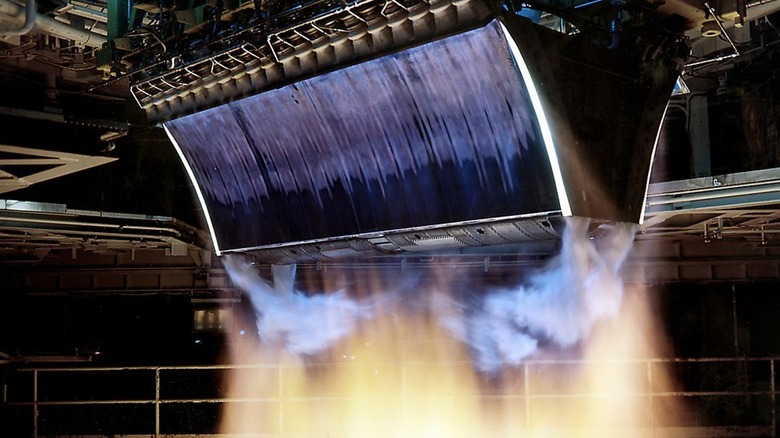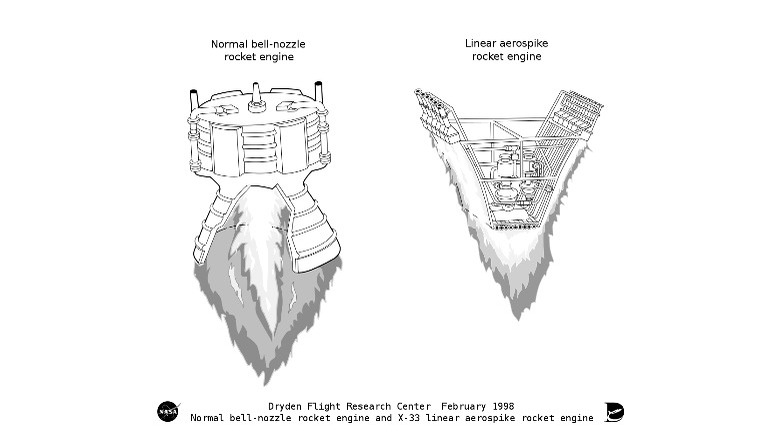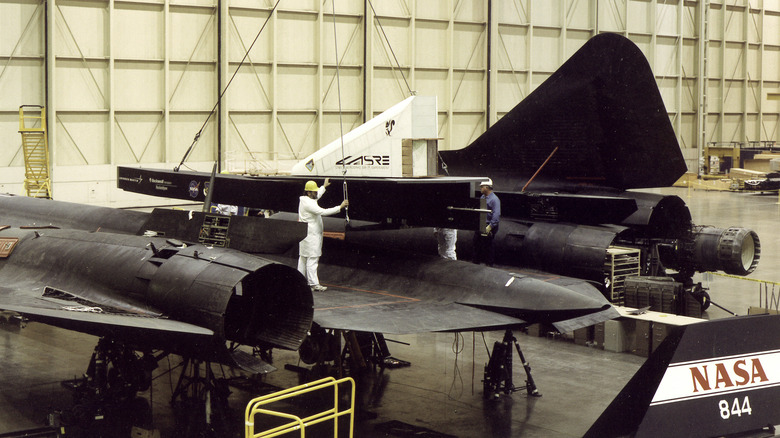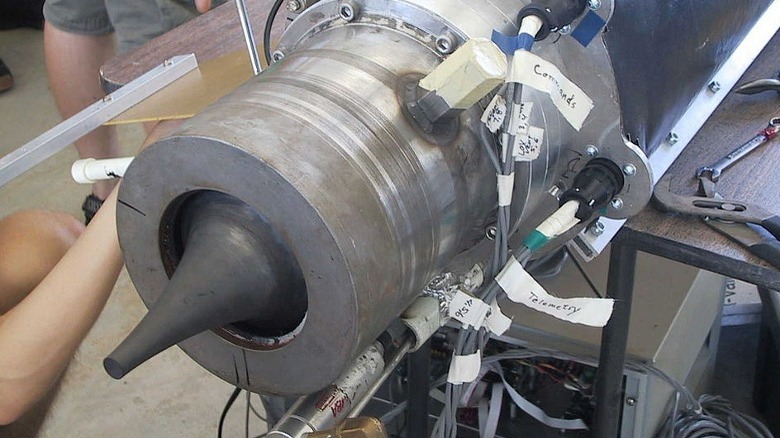Aerospike Engines Explained: Could They Really Be The Future Of Spaceflight?
Since the 1950s rocket engineers have toyed with the idea of a novel engine design that could –- in theory –- revolutionize the way we conceive of space travel. The aerospike might sound like a science fiction writer's concept of an advanced space weapon or warp drive of some kind, but it's a real life concept that could be used in the near future to propel rockets into and throughout the void of outer space.
The aerospike engine flips the nozzle design of the lower engine segment on its head. Instead of funneling the engine's force in a singular direction, this nozzle design would instead deliver thrust in a graduated manner that shifts naturally alongside barometric pressure (the force that makes the conventional design less effective as a rocket continues on its path). The Aerospike engine isn't a high concept either, like a fusion reactor that might be commonplace in the advanced societies of spacefaring, fictional humans of the future. Instead, the aerospike engine may in fact be just over the horizon. In May 2023 it was announced that the German government had awarded a German startup, Polaris, a contract to develop a linear aerospike rocket engine (LAS). This is perhaps the first major push to reestablish aerospike research since it fell by the wayside with the cancellation of NASA's X-33 project in 2001.
[Featured image by NASA Marshall Space Flight Center via Wikimedia Commons | Cropped and scaled | CC BY-SA 3.0]
Conventional, bell-shaped engine nozzles are essentially the inverse of an aerospike
To understand the aerospike engine, it's important to start with an explanation of the existing propulsion model. The conventional rocket engine uses a bell-shaped nozzle at the bottom of the apparatus. This allows the rocket to ignite and funnel the force of its burning fuel downward in a linear direction. A conventional nozzle is built with a specific shape in mind that's fine-tuned for incredible effectiveness at a certain altitude. Typically, the nozzle will be optimized to output its best performance at sea level. This means that the takeoff stage of a rocket launch gains the most engine effectiveness of the entire process. Launching a rocket from a static position takes enormous force, and this optimization helps ensure that the rocket in question can get airborne and begin traveling skyward.
The design funnels force downward in a direct line, but as the rocket moves away from this optimal altitude the nozzle loses efficiency and the force increasingly widens. While still providing enough thrust to continue the ascent, the force increasingly propels the rocket with a diminishing level of effectiveness. As another example, the space shuttle program developed aircraft that had engine nozzles optimized for the pressure of space rather than launch because this is where the important maneuvering would take place. Engineers sacrificed takeoff efficiency for a different function.
In contrast, an aerospike engine uses a point rather than a bell shape to deliver thrust. As pressure changes, the nozzle responds to the shifting air pressure and the dual jets of expelled gas continue to apply force from the engine directly in line with the rocket.
[Featured image by Clh288 via Wikimedia Commons | Cropped and scaled | Public Domain]
Aerospike engines are (conceptually) more efficient force generators, on the whole
While a conventional engine nozzle shape offers optimized force generation at a particular altitude (like at sea level for peak efficiency at liftoff), the aerospike design is more efficient throughout the entirety of a vessel's flight. The physical construction helps direct the flow of fuel in a straight line downward, and instead of relying on the sides of the nozzle to manage the air pressure, the flow created by the cone itself allows the air pressure to focus the force, regardless of the altitude and resulting strength of the air's force. The ability of the aerospike to adjust to changing air pressure makes it an efficient force generator across the entire journey of the vessel. This means that a rocket could use a single stage to initiate liftoff and then traverse the skies rather than multiple, breakaway rocket stages.
As a result, engineers could begin to build far superior spacecraft with the help of these versatile engines. Rather than constructing single-use assemblies to launch a craft into space and then navigate once it exits atmospheric territory, an aerospike engine could usher in a new era of shuttle-like travel that brings a fully reusable vessel to the fore. Even so, there has never been an air test with this type of engine, so the technology still requires substantial research and development to go from concept to reality.
The aerospike design can save roughly 40% in fuel costs (with added knock on effects)
Analysis of the design suggests that rockets utilizing an aerospike engine can save around 40% in fuel usage. The improved thrust efficiency across the entire journey of a rocket's trajectory means that a vessel powered by an aerospike requires less fuel to complete its mission. This is obviously seen prominently in a reduction of fuel costs at the beginning of any new launch sequence. But the price of rocket fuel isn't the only place where this savings is seen.
With a smaller fuel consumption figure comes a lighter overall load within the rocket as it prepares to launch. This can translate into a smaller fuel tank and either a diminished footprint overall or larger cargo and passenger compartments that can augment the mission tasks set out by the crew and its support staff. A lighter total weight means less required thrust to achieve liftoff, as well. Overall, the efficiency that the aerospike engine brings to the table can make for a vastly improved flight in all its facets.
[Featured image by Gbleem via Wikimedia Commons | Cropped and scaled | CC BY-SA 3.0]
The aerospike may be the breakthrough necessary to fuel effective planetary travel
With the new interest in revisiting aerospike engine design, it's possible that we are, collectively, on the verge of a new era of space travel. While there is still much work to do to make this propulsion system a viable means of space exploration, the use of an aerospike design could allow for travel to and – importantly – back from celestial bodies, like the Moon or Mars.
Rather than demanding the establishment of permanent bases or settlements (including the procurement of resources on these worlds), astronauts-turned-explorers would be capable of traveling to a distant moon or planet and then lifting off again to return home once their mission is complete. Thus far, the ability to traverse the stars like this remains uniquely in the realm of science fiction. Yet, humanity appears poised to potentially break this monumental barrier to travel around the solar system with the functional establishment of a reusable, single-stage engine that isn't susceptible to atmospheric interference or efficiency loss during certain phases of the voyage.




